Kauai, Part II: A Very Touristy Day
Long post with heavy pictures behind the cut
I love travel but I hate tourists. I’ve grappled with how to reconcile this, and have thrown up my hands and gone for the old “I am large/I contain multitudes” cop-out. How can I hate what I so enjoy being? Maybe it’s a kind of shame by association: seeing all the crude and obnoxious tourists; that mob with belt packs and visors trundling the Earth, breathing with open mouths, gaping at Paradise through a Handycam viewfinder, expecting every local to serve their most asinine requests in perfect English and wondering where the nearest McDonald’s is. The ones who either seem confused or miffed or snippy; never happy. The ones who walk around like they bought and paid for the whole place and no one actually has to work or live here, it’s just all giant make-believe like one of those World Showcase Pavilions at Epcot that reduces every beautiful and complex culture on Earth to a restaurant with a kids’ menu and a gift shop.
I know I’m running with that herd, but every fiber in me makes a silent cry to the people who live where I travel – I want them to understand, I get it. I’m not like all these people. You can relax.
Maybe I succeed sometimes. Maybe most of the time I look like just as much of a yutz as the rest.
Monkeygirl and I had a conversation about this in Kauai – it seemed alien to her that I could have such strongly negative feelings towards any class of people. Darling that she is, she doesn’t think I have it in me:
“But you seem to like people.”
Do I?
“You’re more likely to talk to strangers than I am.”
I don’t think that I go out of my way. People just seem to want to talk to me and I try to be polite. The crazier they are, the more likely they’ll find me.
“Well, there is something inviting about you.”
She always knows what to say.
Our guide for today’s van tour is named Damien. He looks like a slender Wayne Newton without all the unfortunate cosmetic work, and he has a single thumbnail grown out so far it curls inward. I remember the cab driver from the ride in and wonder if it’s an island tradition to use extreme grooming attributes as distinguishing characteristics.
To Damien, all flora and fauna are divided into two very important categories, they are either “indigenous”, born to this beautiful island and thus part of its blessed harmony, or “Goodfa NATHING!”, meaning the honkeys brought it and it’s running amok and ruining everything. He has a bottomless supply of possibly-true facts and anecdotes about the living and growing things that we cruise by in our mini-coach, and which category they belong to; particularly the cursed cattle egret, which eats bugs off cows in Florida and was imported to serve the same function, only there weren’t many of the right bugs on the Hawaiian cows to begin with so the egrets took to eating all the bugs on the ground, which the other animals were sort of counting on for their next meal. Every time we see a cattle egret near the road, Damien growls and swerves to try and run it over. It is the only time he strays from an inexhaustibly effusive manner.
He never mentions the picky fact that the cows themselves probably didn’t evolve here naturally. And thus I am alerted to the existence of the secret third category – the living things that have proven relatively useful despite not being indigenous.
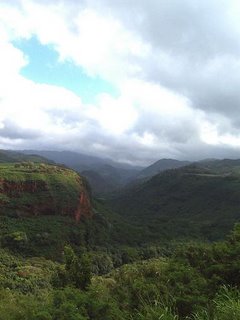
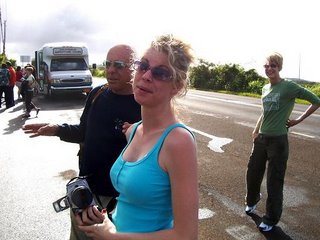
Like her parents, Monkeygirl won’t get up early for much, but they’re making an exception this time
First we’ll stop at a vista designed to set cameras clicking, then we’ll proceed to a gift shops where we can stretch our legs, tidy up and spend a few dollars convincing our loved ones we were thinking of them. Gift shop employees are another class of people I’m always trying to psychically communicate with. I want them to know they don’t have to play the ruse with me, that I know this cheap crap doesn’t really represent what they’re capable of; that it reduces, confines. I’m here for the good and the real, and just possibly if I can find it, the immortally-weird.
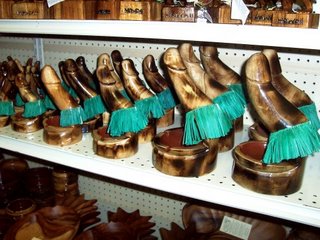
Your eyes aren’t deceiving you, and there’s nothing wrong with you for seeing what you see
As we alternate between these two extremes, Damien tells us about papaya trees, and noni, the plant that can cure everything, and the difference between Chinese bananas and Hawaiian apple bananas, about “tourist pineapples” that trick the uninformed into thinking they grow on trees. The trouble is, he often neglects to point at which specific tree of the many around us possesses the unusual qualities he’s describing.
We pass the point where Captain Cook first landed, and was worshipped as the god Lono. Damien’s frequent references to “the great explorer, Captain James Cook” get subconsciously re-written in my brain, and this reminds me of what a flaming nerd I am.
***
The Hawaiian language only requires a twelve-letter alphabet to transcribe, which is kind of inspiring, as it suggests the argot of a life too simple and serene to require any more. “Wai” means water. If you’ve got water, you can grow taro, the main food and the basic ingredient in poi, so “Wai wai” means “wealthy”. A mile-high mountain peak at the center of the island, where there’s an annual rainfall of about 460 inches, making it a regular finalist for wettest place on the planet, is called “Wai’ale’ale”: rippling waters. And that all makes a lovely sort of sense, you can practically see the hula dancer making an ale’ale motion with her gentle hand.
At an overlook for Waimea Canyon, far more expansive and detailed than my little digital camera could truly do justice to, Papa Monkeygirl falls into dizzying love with a fresh coconut, the kind where they whack off the top with a machete and stick a straw in right in front of you. You can always spot a man in taste delirium – because first he offers to share, wanting to know someone else feels the nirvana he now knows, then he suspiciously eyes how much of it you’re taking for yourself. But Monkeygirl and I get enough of the sweet water and the pulpy meat to sate us until lunch.
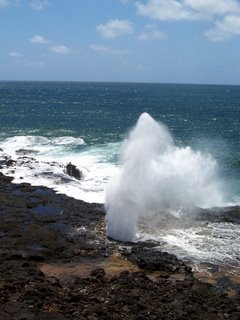
This is Spouting Horn, a blowhole which also has a separate nearby hole that funnels air, creating a full-bodied groaning sound. The superstitious explanation holds that inside the lava tube a giant lizard called a mo’o lies trapped. She was tricked in there by a fisherman and now wails in hunger and fury forever.
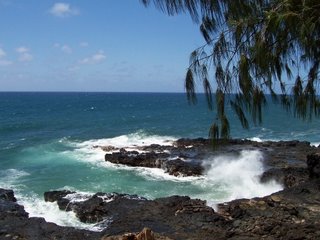
Lunch is at a golf club on the dry side of the island. Kauai fits a rather extraordinary variety of weather patterns for such a small bit of earth due to its position in the flow of the tradewinds. Over on the wet half, it’s likely to rain at least three or four times on any given day, usually just a few minutes of fresh cooling sprinkle – God’s version of a grocery store veggie mister, if I can be insultingly reductive. It gets to where you hardly mind being out in it, since you know it’s more likely than not to pass soon. Winds vary wildly, clouds practically tumble across the sky, changing you from overcast to brilliant sun hour by hour.
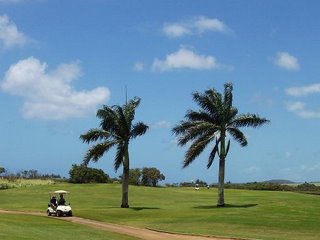 It keeps everything green, that’s for sure.
It keeps everything green, that’s for sure.
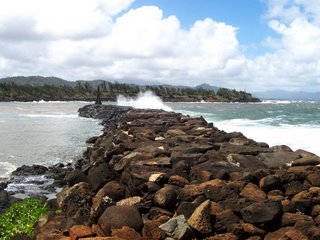
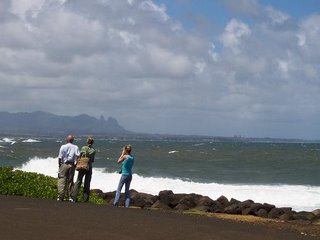
The tour is going on much longer than expected. We’d paid for the 5-hour version, but we’re getting a 7-hour version whether we like it or not. It’s testing the endurance of all of us, although Mama and Papa Monkeygirl are the more vocal about it. Papa Monkeygirl tries to bribe Damien to take an early detour back to our condo. We were up early and we’ve still got a luau to get ready for, which leaves us hardly any time at all for the very important business of laying by the pool.
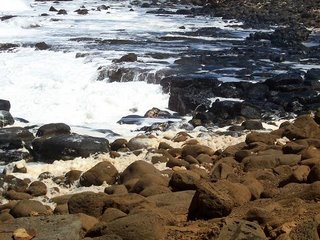
Little wisps of sea foam would drift up the rocks like liquid tumbleweeds

The monk seal is an endangered species, when you see one you’re supposed to notify wildlife authorities. You are not to touch it, and you especially are not to disturb its sleep, no matter where it feels like napping. And these things sleep a lot. Which may explain the Darwinian bind they find themselves in.
The last stop is one of the many waterfalls we’ll see this week. Water runs off Kauai, from Mt. Wai’ale’ale down, as if poured from a bucket, spidering out from the peak through canyons and over falls into the rivers that connect them to the ocean. It is constant, it is clean, it is beautiful.
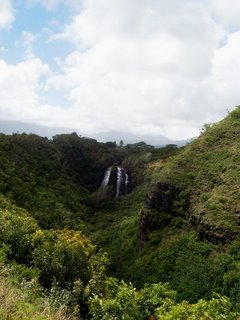

See that house on top? If a guy lives up there, I’d wager $10,000 that he’s taken a leak over the falls*
There are a few pictures of Monkeygirl and I at these beautiful sites, but I look fat in all of them and that ain’t what you’re here to see, is it, Jimmy?
***
Hawaiians have a lot of practice at luaus now, and as smoothly as the process of slaughtering a pig and burying it in an underground oven must go for them by now, they’re even better at herding the tourists through. Monkeygirl has a compelling theory about how the food at these occasions can’t, by its nature, be too good, because the luau isn’t Hawaii. It’s like Hawaii: the Drive-Through Experience – a little song and dance, a little fashion show, some drinks, a language lesson and that little saucer of poi you try a bit of and then wonder why anyone would think it does anything to food but make it more slimy and purple (the need for said qualities never having been noted for any dish produced by our Immaculate Western Civilization.)
As they go, the Hiva Pasefika Luau is entertaining enough, confined as it is to a covered open-air hall of long tables and uncomfortable chairs. The food is acceptable and they don’t rush to cut off the buffet, the free booze isn’t too watery and by the time you move up to the stuff you have to pay for you don’t mind the cheap mixes too much. The host has a gentle singing voice and an impenetrable helmet of hair.
A few tourists are coaxed on stage so we can laugh at their amateur dancing style, and the hula girls do the basic routines well. I can’t imagine the muscles built up by hours of that fluid pedaling heel-toe motion. Monkeygirl asks me which ones’ calves I like the most. You truly can’t have hula hips without actual meat on your bones, and there’s something mesmerizing about those soft, fleshy, curves and the buttery skin. You see them and you think about this place of plenty which has found healthy balance with itself and is filled with life and joy. And you get horny.
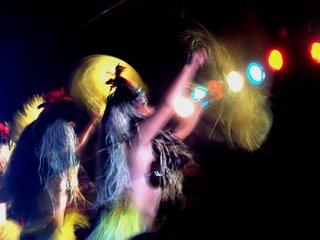
Much as I’d like to take credit for this picture, it’s all Monkeygirl’s doing
We do a sing-a-long. There’s a fire twirler who brings the house down, the hardest five minutes that ever constituted a person’s day job. A little girl comes out to give a sort of one-person junior showcase, not prodigious by any stretch of the imagination but studied and confident, so everyone can be impressed and wonder why their own children don’t have any damned talent yet. There’s a glitch and the lights drop off, and she soldiers on in total blackness without a flinch. Maybe half of her routine is lost, but she’s a trouper and that’s to be admired.
I’ve reached total language overload. That charm for the lingo I felt earlier has been smothered by so many complex vowel constructions that they could be just making it all up and I would never be cognizant enough to call shenanigans. I’m sure this has happened: Yes, this is what we call the Ha’lonikiwala Uhi, which means “Cash Bar Only”.
It was healthy, I think, for us to get this stuff out of the way early, so we can be briefed enough to proceed to more in-depth appreciations. But this has been a long day, and when you’ve seen a middle-aged guy three mai tai’s in the bag wearing large-rimmed glasses, a tucked-in polo shirt and a cell phone in a belt pouch holding fake grass pom-poms and shaking his moneymaker, I’ve passed my endurance point with the tourist horde. Time for bed, and time to start moving in smaller packs to more specific destinations. Time to get past all that first date pretense and really get to know Kauai.
(*Note – Any and all wagers made on this blog, if accepted, will be paid in crinkled Monopoly money.)
I love travel but I hate tourists. I’ve grappled with how to reconcile this, and have thrown up my hands and gone for the old “I am large/I contain multitudes” cop-out. How can I hate what I so enjoy being? Maybe it’s a kind of shame by association: seeing all the crude and obnoxious tourists; that mob with belt packs and visors trundling the Earth, breathing with open mouths, gaping at Paradise through a Handycam viewfinder, expecting every local to serve their most asinine requests in perfect English and wondering where the nearest McDonald’s is. The ones who either seem confused or miffed or snippy; never happy. The ones who walk around like they bought and paid for the whole place and no one actually has to work or live here, it’s just all giant make-believe like one of those World Showcase Pavilions at Epcot that reduces every beautiful and complex culture on Earth to a restaurant with a kids’ menu and a gift shop.
I know I’m running with that herd, but every fiber in me makes a silent cry to the people who live where I travel – I want them to understand, I get it. I’m not like all these people. You can relax.
Maybe I succeed sometimes. Maybe most of the time I look like just as much of a yutz as the rest.
Monkeygirl and I had a conversation about this in Kauai – it seemed alien to her that I could have such strongly negative feelings towards any class of people. Darling that she is, she doesn’t think I have it in me:
“But you seem to like people.”
Do I?
“You’re more likely to talk to strangers than I am.”
I don’t think that I go out of my way. People just seem to want to talk to me and I try to be polite. The crazier they are, the more likely they’ll find me.
“Well, there is something inviting about you.”
She always knows what to say.
Our guide for today’s van tour is named Damien. He looks like a slender Wayne Newton without all the unfortunate cosmetic work, and he has a single thumbnail grown out so far it curls inward. I remember the cab driver from the ride in and wonder if it’s an island tradition to use extreme grooming attributes as distinguishing characteristics.
To Damien, all flora and fauna are divided into two very important categories, they are either “indigenous”, born to this beautiful island and thus part of its blessed harmony, or “Goodfa NATHING!”, meaning the honkeys brought it and it’s running amok and ruining everything. He has a bottomless supply of possibly-true facts and anecdotes about the living and growing things that we cruise by in our mini-coach, and which category they belong to; particularly the cursed cattle egret, which eats bugs off cows in Florida and was imported to serve the same function, only there weren’t many of the right bugs on the Hawaiian cows to begin with so the egrets took to eating all the bugs on the ground, which the other animals were sort of counting on for their next meal. Every time we see a cattle egret near the road, Damien growls and swerves to try and run it over. It is the only time he strays from an inexhaustibly effusive manner.
He never mentions the picky fact that the cows themselves probably didn’t evolve here naturally. And thus I am alerted to the existence of the secret third category – the living things that have proven relatively useful despite not being indigenous.


First we’ll stop at a vista designed to set cameras clicking, then we’ll proceed to a gift shops where we can stretch our legs, tidy up and spend a few dollars convincing our loved ones we were thinking of them. Gift shop employees are another class of people I’m always trying to psychically communicate with. I want them to know they don’t have to play the ruse with me, that I know this cheap crap doesn’t really represent what they’re capable of; that it reduces, confines. I’m here for the good and the real, and just possibly if I can find it, the immortally-weird.

As we alternate between these two extremes, Damien tells us about papaya trees, and noni, the plant that can cure everything, and the difference between Chinese bananas and Hawaiian apple bananas, about “tourist pineapples” that trick the uninformed into thinking they grow on trees. The trouble is, he often neglects to point at which specific tree of the many around us possesses the unusual qualities he’s describing.
We pass the point where Captain Cook first landed, and was worshipped as the god Lono. Damien’s frequent references to “the great explorer, Captain James Cook” get subconsciously re-written in my brain, and this reminds me of what a flaming nerd I am.
The Hawaiian language only requires a twelve-letter alphabet to transcribe, which is kind of inspiring, as it suggests the argot of a life too simple and serene to require any more. “Wai” means water. If you’ve got water, you can grow taro, the main food and the basic ingredient in poi, so “Wai wai” means “wealthy”. A mile-high mountain peak at the center of the island, where there’s an annual rainfall of about 460 inches, making it a regular finalist for wettest place on the planet, is called “Wai’ale’ale”: rippling waters. And that all makes a lovely sort of sense, you can practically see the hula dancer making an ale’ale motion with her gentle hand.
At an overlook for Waimea Canyon, far more expansive and detailed than my little digital camera could truly do justice to, Papa Monkeygirl falls into dizzying love with a fresh coconut, the kind where they whack off the top with a machete and stick a straw in right in front of you. You can always spot a man in taste delirium – because first he offers to share, wanting to know someone else feels the nirvana he now knows, then he suspiciously eyes how much of it you’re taking for yourself. But Monkeygirl and I get enough of the sweet water and the pulpy meat to sate us until lunch.

This is Spouting Horn, a blowhole which also has a separate nearby hole that funnels air, creating a full-bodied groaning sound. The superstitious explanation holds that inside the lava tube a giant lizard called a mo’o lies trapped. She was tricked in there by a fisherman and now wails in hunger and fury forever.

Lunch is at a golf club on the dry side of the island. Kauai fits a rather extraordinary variety of weather patterns for such a small bit of earth due to its position in the flow of the tradewinds. Over on the wet half, it’s likely to rain at least three or four times on any given day, usually just a few minutes of fresh cooling sprinkle – God’s version of a grocery store veggie mister, if I can be insultingly reductive. It gets to where you hardly mind being out in it, since you know it’s more likely than not to pass soon. Winds vary wildly, clouds practically tumble across the sky, changing you from overcast to brilliant sun hour by hour.
 It keeps everything green, that’s for sure.
It keeps everything green, that’s for sure.

The tour is going on much longer than expected. We’d paid for the 5-hour version, but we’re getting a 7-hour version whether we like it or not. It’s testing the endurance of all of us, although Mama and Papa Monkeygirl are the more vocal about it. Papa Monkeygirl tries to bribe Damien to take an early detour back to our condo. We were up early and we’ve still got a luau to get ready for, which leaves us hardly any time at all for the very important business of laying by the pool.


The last stop is one of the many waterfalls we’ll see this week. Water runs off Kauai, from Mt. Wai’ale’ale down, as if poured from a bucket, spidering out from the peak through canyons and over falls into the rivers that connect them to the ocean. It is constant, it is clean, it is beautiful.


There are a few pictures of Monkeygirl and I at these beautiful sites, but I look fat in all of them and that ain’t what you’re here to see, is it, Jimmy?
Hawaiians have a lot of practice at luaus now, and as smoothly as the process of slaughtering a pig and burying it in an underground oven must go for them by now, they’re even better at herding the tourists through. Monkeygirl has a compelling theory about how the food at these occasions can’t, by its nature, be too good, because the luau isn’t Hawaii. It’s like Hawaii: the Drive-Through Experience – a little song and dance, a little fashion show, some drinks, a language lesson and that little saucer of poi you try a bit of and then wonder why anyone would think it does anything to food but make it more slimy and purple (the need for said qualities never having been noted for any dish produced by our Immaculate Western Civilization.)
As they go, the Hiva Pasefika Luau is entertaining enough, confined as it is to a covered open-air hall of long tables and uncomfortable chairs. The food is acceptable and they don’t rush to cut off the buffet, the free booze isn’t too watery and by the time you move up to the stuff you have to pay for you don’t mind the cheap mixes too much. The host has a gentle singing voice and an impenetrable helmet of hair.
A few tourists are coaxed on stage so we can laugh at their amateur dancing style, and the hula girls do the basic routines well. I can’t imagine the muscles built up by hours of that fluid pedaling heel-toe motion. Monkeygirl asks me which ones’ calves I like the most. You truly can’t have hula hips without actual meat on your bones, and there’s something mesmerizing about those soft, fleshy, curves and the buttery skin. You see them and you think about this place of plenty which has found healthy balance with itself and is filled with life and joy. And you get horny.

We do a sing-a-long. There’s a fire twirler who brings the house down, the hardest five minutes that ever constituted a person’s day job. A little girl comes out to give a sort of one-person junior showcase, not prodigious by any stretch of the imagination but studied and confident, so everyone can be impressed and wonder why their own children don’t have any damned talent yet. There’s a glitch and the lights drop off, and she soldiers on in total blackness without a flinch. Maybe half of her routine is lost, but she’s a trouper and that’s to be admired.
I’ve reached total language overload. That charm for the lingo I felt earlier has been smothered by so many complex vowel constructions that they could be just making it all up and I would never be cognizant enough to call shenanigans. I’m sure this has happened: Yes, this is what we call the Ha’lonikiwala Uhi, which means “Cash Bar Only”.
It was healthy, I think, for us to get this stuff out of the way early, so we can be briefed enough to proceed to more in-depth appreciations. But this has been a long day, and when you’ve seen a middle-aged guy three mai tai’s in the bag wearing large-rimmed glasses, a tucked-in polo shirt and a cell phone in a belt pouch holding fake grass pom-poms and shaking his moneymaker, I’ve passed my endurance point with the tourist horde. Time for bed, and time to start moving in smaller packs to more specific destinations. Time to get past all that first date pretense and really get to know Kauai.
(*Note – Any and all wagers made on this blog, if accepted, will be paid in crinkled Monopoly money.)

0 Comments:
Post a Comment
<< Home